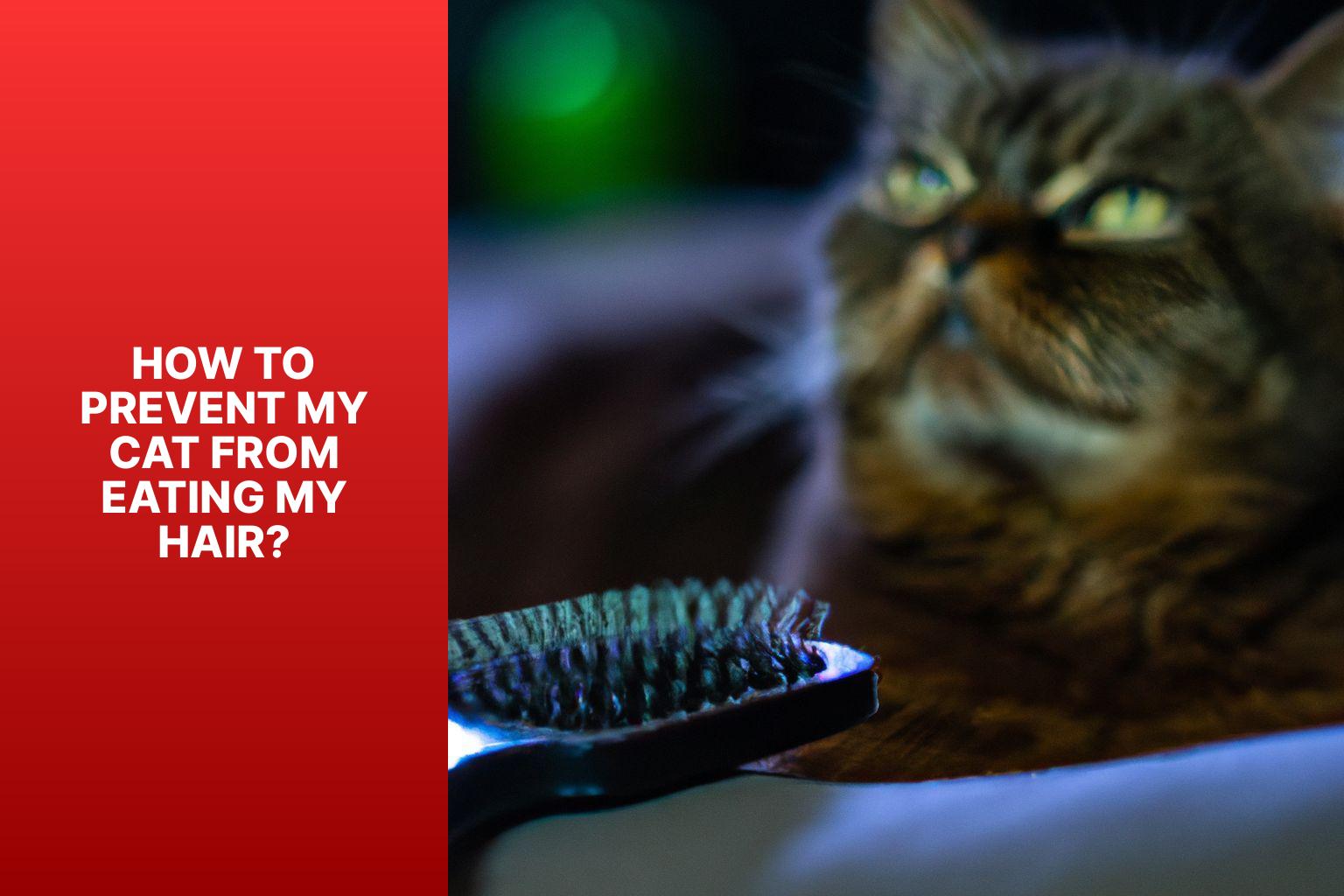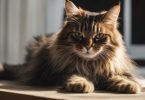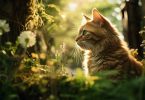Cats are known for their curious and sometimes peculiar behaviors, including their eating habits. It can be concerning and puzzling to witness your cat eating your hair or exhibiting strange eating behaviors. Understanding the reasons behind these behaviors is crucial in determining whether it is normal or if intervention is necessary.
One possible explanation for these behaviors is a condition called pica, which is characterized by the ingestion of non-food items. Pica can be caused by various factors, including nutritional deficiencies, gastrointestinal issues, or behavioral problems.
Specifically regarding the act of eating hair, it is essential to explore the reasons why your cat engages in this behavior. While it may seem odd, some cats do eat hair, including their own or their human’s.
Determining whether it is normal for cats to eat hair requires a closer look at potential underlying factors:
- Behavioral Reasons: Some cats may eat hair as a result of anxiety, stress, or boredom. It can serve as a form of self-soothing or a way to seek attention.
- Nutritional Deficiencies: Cats lacking essential nutrients in their diet, such as fiber or certain minerals, may exhibit pica-like behaviors, including eating hair.
Preventing your cat from eating hair involves implementing various strategies, such as improving grooming practices, providing mental and physical stimulation, and ensuring a balanced diet. If the behavior persists or becomes problematic, seeking professional help from a veterinarian or animal behaviorist is recommended.
It is crucial to be vigilant and recognize when your cat’s hair-eating behavior becomes a cause for concern. Excessive hair consumption, signs of gastrointestinal distress, or changes in behavior or appetite may indicate a more significant issue that requires immediate attention.
By understanding the underlying causes of why cats eat hair and taking appropriate steps to address and prevent this behavior, you can ensure the well-being of your feline companion.
Key takeaway:
- Cats exhibit strange eating behaviors: Cats may exhibit strange eating behaviors due to a condition called pica. Pica is when cats eat non-food items, such as hair.
- Hair consumption by cats can be normal: While it may seem strange, it can be normal for cats to eat hair. Excessive hair consumption could be a cause for concern.
- Possible reasons for cats eating hair: Cats may eat hair due to behavioral reasons or nutritional deficiencies. It is important to address these issues to prevent harm to the cat.
Why Do Cats Exhibit Strange Eating Behaviors?
Cats exhibit strange eating behaviors for several reasons. Why do cats exhibit strange eating behaviors? They may engage in these behaviors due to their natural hunting instincts. Some cats “play” with their food before eating it. Other cats have selective eating habits, choosing only certain types of food or textures. These preferences may be influenced by taste or dental issues. Boredom or stress can also cause cats to exhibit strange eating behaviors. In some cases, cats may eat non-food items like hair or plastic for entertainment or comfort. To prevent these habits, it is important to provide cats with stimulating environments and outlets for natural behaviors. Understanding why cats exhibit strange eating behaviors helps cat owners ensure their pets’ health and nutrition.
What Is Pica in Cats?
Pica in cats is when they engage in the behavior of eating non-food items. Cats may consume hair, fabric, plastic, or rocks. Pica is a common behavior that can be observed in cats. Cats may engage in pica due to either nutritional deficiencies or behavioral reasons.
Nutritional deficiencies can be a cause for cats exhibiting pica. It is possible for cats to eat non-food items in order to obtain the minerals or nutrients that they may be lacking. For instance, if a cat lacks fiber in its diet, it may resort to consuming hair or fabric to fulfill its need for roughage.
Behavioral reasons for pica in cats can include stress, anxiety, or boredom. Cats may consume non-food items as a means to alleviate anxiety or to satisfy their need for stimulation.
If you notice your cat displaying pica behavior, it is crucial to identify the underlying cause. This process may involve improving the cat’s diet and providing mental and physical stimulation through playtime and interactive toys.
If the pica behavior persists or worsens, it is advisable to seek guidance from a veterinarian. They can evaluate the cat’s health and behavior to determine the most effective approach for addressing pica and promoting the cat’s overall well-being.
Why Does My Cat Eat My Hair?
Cats may eat human hair for several reasons. One reason is their natural attraction to the texture and smell of hair. They may also ingest hair accidentally while grooming. In some cases, cats may have a compulsive behavior called pica, which leads them to eat non-food items, including hair. If your cat frequently eats your hair, monitor their behavior and consult a veterinarian to rule out any underlying medical conditions. To prevent this behavior, keep your hair out of reach by tying it up or wearing a hat. Providing your cat with appropriate toys and enrichment activities can redirect their attention away from hair consumption. Regular grooming and a well-balanced diet can also support your cat’s overall health and reduce the likelihood of them seeking out hair as a substitute. So, why does my cat eat my hair?
Is It Normal for Cats to Eat Hair?
Is it normal for cats to eat hair? Cats groom themselves and sometimes ingest a little of their fur, but eating a lot of hair is not normal. Cats have barbs on their tongues to help with grooming and removing loose fur. Excessive grooming or hair consumption could indicate an underlying issue.
There are a few reasons why cats eat hair. One reason may be behavioral, such as stress or boredom. Cats might excessively groom and eat hair to cope with these feelings. Another reason could be nutritional deficiencies. If a cat lacks nutrients in their diet, they may eat hair or other non-food items.
If you notice your cat eating hair, address the underlying cause. Provide enrichment and mental stimulation through toys, playtime, and interactive feeders to alleviate boredom. Ensure a balanced and nutritious diet to prevent nutritional deficiencies. If the behavior continues or you’re concerned about your cat’s health, consult a veterinarian for further evaluation and guidance.
Behavioral Reasons
Hair eating in cats is a common but peculiar behavior. Cats may eat hair due to various behavioral reasons. One possible reason is stress or anxiety. This behavior serves as a coping mechanism for them.
Another reason for hair eating is attention-seeking. Some cats learn that by eating hair, they can get attention from their owners, such as being petted or receiving attention.
Cats who are bored or lack mental or physical stimulation may also engage in hair eating. It becomes a way for them to entertain themselves.
Hair eating can also be an extension of normal grooming behavior. Cats may accidentally ingest hair while licking their fur.
Cats are observant animals and may imitate behaviors they see their owners doing. If they see their owner touching or playing with hair, they may imitate that behavior by eating hair.
While hair eating may not pose a serious health risk, it is important to monitor your cat’s hair consumption to ensure it does not cause gastrointestinal distress or other health issues.
Nutritional Deficiencies
Nutritional deficiencies can have a significant impact on a cat’s health and eating behaviors. It is crucial to consider certain key points regarding nutritional deficiencies in cats:
– Dietary imbalances: Cats require specific nutrients to maintain good health. Insufficient intake of essential vitamins, minerals, and amino acids can lead to deficiencies. Therefore, it is important to ensure that your cat’s diet is complete and balanced.
– Protein deficiency: Since cats are obligate carnivores, they need protein from animal sources. Inadequate protein intake can result in malnutrition and muscle wasting. It is essential to include high-quality sources of protein in your cat’s diet.
– Taurine deficiency: Taurine is an essential amino acid for cats. Low levels of taurine can lead to heart disease and vision problems. While commercial cat foods typically meet taurine requirements, homemade or unbalanced diets may lack sufficient taurine content.
– Calcium and phosphorus imbalance: Cats require appropriate levels of calcium and phosphorus for healthy bones. Imbalances in these minerals can cause skeletal abnormalities and growth issues. Therefore, it is crucial to ensure that your cat’s diet provides adequate levels of both calcium and phosphorus.
– Vitamin deficiencies: Cats need specific vitamins like A, D, and E for overall health. Insufficient intake of these vitamins can result in various health problems. To ensure that your cat’s diet meets all vitamin requirements, it is advisable to consult a veterinarian.
To prevent nutritional deficiencies in cats, it is important to schedule regular veterinary check-ups and provide a well-balanced diet. If you suspect a deficiency, seek professional advice promptly to safeguard your cat’s well-being.
How to Prevent My Cat from Eating My Hair?
Photo Credits: Www.Catcornerblog.Com by Bobby Martin
Tired of finding your cat chowing down on your precious locks? Discover effective strategies to stop this peculiar behavior! From implementing grooming practices to ensuring your feline friend receives ample mental and physical stimulation, we’ve got you covered. Plus, we’ll reveal the importance of maintaining a balanced diet and when to seek professional assistance. Bid farewell to hair-eating antics and create a harmonious environment with your furry companion. Let’s dive into the world of preventing hair-eating cats!
Grooming Practices
Grooming practices are essential for maintaining the health and well-being of your cat. Regular grooming keeps their fur clean, untangled, and free from mats. Here are some effective grooming practices to follow:
1. Brushing: Remove loose hair and prevent tangling or ingestion. Use a suitable brush or comb for your cat’s coat.
2. Bathing: Occasional baths may be necessary if your cat gets dirty or has a skin condition. Use cat-friendly shampoos and proper techniques for comfort and safety.
3. Nail trimming: Regularly trim sharp and long nails using cat nail clippers or trimmers. Seek assistance if unsure.
4. Dental care: Maintain healthy teeth and gums by regularly brushing your cat’s teeth with vet-approved tools.
5. Ear cleaning: Periodically clean the outer ear using a gentle cat ear cleaner and cotton balls. Avoid going too deep into the ear canal.
Remember, grooming sessions should be positive and stress-free. Offer treats and rewards for good behavior. Seek professional help if needed.
Regular grooming not only ensures hygiene but also provides bonding opportunities. Incorporate these grooming practices into your routine to keep your cat looking and feeling their best.
Providing Adequate Mental and Physical Stimulation
To ensure your cat’s well-being, provide them with enough mental and physical stimulation. Here are some ways to achieve this:
- Playtime: Engage your cat in interactive play using toys like feather wands or laser pointers. This helps them release energy and satisfy hunting instincts.
- Environmental Enrichment: Create a stimulating environment with scratching posts, climbing trees, and hiding spots. This encourages exploration and keeps their minds active.
- Puzzle Toys: Use toys that challenge your cat’s problem-solving skills and dispense food while they eat.
- Training: Teach your cat basic commands using positive reinforcement. This stimulates their mind and strengthens the bond between you and your pet.
- Window Views: Allow your cat to observe the outside world by giving them access to windows or installing bird feeders. Watching birds and small animals provides mental stimulation.
By incorporating these strategies into your cat’s daily routine, you can ensure they have the mental and physical stimulation necessary for a happy and healthy life.
Ensuring a Balanced Diet
To ensure a balanced diet for your cat, consider the following:
- Choose high-quality cat food: Look for complete and balanced cat food with high-quality protein sources like chicken or fish, and avoid fillers or artificial additives.
- Provide a variety of protein sources: Cats need a diet rich in animal protein, so offer poultry, fish, and beef to ensure essential amino acids.
- Incorporate essential fatty acids: Maintain your cat’s skin and coat health by looking for cat foods with omega-3 and omega-6 fatty acids, or consider a fish oil supplement.
- Balance carbohydrates: Cats don’t need carbs, so choose cat foods with limited or no carbohydrates to avoid obesity or diabetes.
- Provide appropriate portion sizes: Prevent overfeeding and obesity by following the feeding guidelines on the cat food packaging based on your cat’s weight and activity level.
- Ensure access to fresh water: Always provide clean and fresh water by regularly replacing the water in your cat’s bowl.
By ensuring a balanced diet for your cat, you can support their overall health and well-being.
Professional Help
If your cat keeps eating your hair despite your efforts to stop it, it is important to consider seeking professional help. There are various options available to you:
- Veterinarian: Make an appointment with your vet to discuss your cat’s behavior. They can examine your cat and run tests to check for any underlying health issues causing the hair eating.
- Animal Behaviorist: Consult an animal behaviorist who specializes in cat behavior. They can assess your cat’s habits, identify triggers or behavioral issues, and provide a customized behavior modification plan.
- Grooming Specialist: Seek help from a professional cat groomer. They can suggest grooming techniques and tools to reduce your cat’s desire to eat hair and maintain a clean and healthy coat.
- Pet Psychologist: Consider consulting a pet psychologist for additional insights into your cat’s behavior and recommendations for managing it.
Remember, professional help is available to support you and your cat. With experts’ guidance, you can address the issue of hair eating and find a solution that works for both of you.
True story: I had a cat that used to eat my hair while I was lying down. Despite my efforts to discourage this behavior, it persisted. I sought help from an animal behaviorist who determined that my cat was doing it out of anxiety and boredom. Through behavior modification techniques and enrichment activities, we were able to redirect my cat’s attention and reduce their hair eating habits. Seeking professional help greatly improved my cat’s overall well-being.
When Should I Be Concerned About My Cat Eating My Hair?
Curiosity piqued? Wondering when your cat’s hair-eating habit might be cause for concern? Let’s dive into the intriguing world of feline behavior and explore the signs to watch out for. Discover the sub-sections that delve deeper into excessive hair consumption, signs of gastrointestinal distress, and changes in behavior or appetite. Get ready to gain valuable insights into your fuzzy friend’s dietary quirks and learn when it’s time to take action!
Excessive Hair Consumption
Cats may engage in excessive hair consumption, or trichophagia, for various reasons. Stress or anxiety can trigger excessive hair consumption in cats, also known as psychogenic alopecia. Medical conditions, such as hyperthyroidism or allergies, can lead to increased grooming and subsequent hair consumption. Cats with hairballs may inadvertently consume excessive amounts of hair while trying to expel the hairball. Boredom or lack of mental stimulation can cause cats to groom excessively and consume more hair. A messy coat or skin condition can result in a cat grooming excessively and ingesting more hair.
To prevent complications like hairballs or gastrointestinal blockages, addressing excessive hair consumption in cats is important. Pro tip: Enrich your cat’s environment with toys, scratching posts, and interactive play to keep them mentally engaged. Regular grooming and a balanced diet can also reduce excessive grooming and hair consumption. If you notice persistent excessive hair consumption or any signs of discomfort, consult your veterinarian for further evaluation and guidance.
Signs of Gastrointestinal Distress
- Cats with gastrointestinal distress may vomit frequently. This can be seen by undigested food or hairballs in the vomit.
- Gastrointestinal distress in cats can cause loose or liquid stools. There may also be changes in the frequency or urgency of bowel movements.
- Abdominal pain can be a sign of gastrointestinal distress in cats. Signs of discomfort may include restlessness, pacing, or hunching over.
- Cats experiencing gastrointestinal distress may lose interest in food or have a decreased appetite. They may also show disinterest in treats or special food items.
- Unintentional weight loss can indicate that a cat is not absorbing necessary nutrients due to gastrointestinal issues.
When observing these signs in cats, it is important to monitor the severity and duration. If the symptoms persist or worsen, it is advisable to consult a veterinarian for further evaluation and appropriate treatment.
Changes in Behavior or Appetite
Changes in behavior and appetite in cats may indicate health issues or discomfort. Pay attention to these changes and take appropriate action. If your cat acts differently, like being lethargic or aggressive, it may indicate illness or pain. Changes in appetite, like a sudden decrease or increase in food intake, should also be a cause for concern.
If you notice any changes in behavior or appetite in your cat, consult a veterinarian. They can evaluate your cat’s health and conduct necessary tests to identify the underlying cause. Addressing potential health issues promptly is crucial for your cat’s well-being. The vet may also provide guidance on dietary changes or behavioral modifications to improve your cat’s behavior and appetite.
Regularly monitor your cat’s behavior and appetite to detect any changes early on. By staying observant and taking prompt action, you can ensure your cat experiences the necessary care and support to maintain their health and happiness. Remember, seeking professional help is always the best approach for changes in behavior or appetite in your beloved feline companion.
Some Facts About Why Cats Eat Their Owner’s Hair:
- ✅ Cats may eat or chew their owner’s hair for several reasons: They do it to socialize, de-stress, soothe themselves, gain attention, play, or simply enjoy the taste or scent of the hair products used. (Source: Our Team)
- ✅ It is a way for cats to show affection: Cats who live in groups tend to groom each other as a way of showing affection and spreading scents. They may see their owner as part of their family and want to groom them as well. (Source: Our Team)
- ✅ Chewing hair can be a self-soothing behavior for cats: It helps them calm down and feel comforted, similar to thumb-sucking in children. (Source: Our Team)
- ✅ Some cats may have a compulsive chewing disorder called Pica: They have a desire to eat non-food items, including hair. This may require veterinary attention. (Source: Our Team)
- ✅ Cats may chew their owner’s hair to seek attention or play: If a cat is bored or seeking attention, it may chew or bite their owner’s hair to wake them up or engage in play. (Source: Our Team)
Frequently Asked Questions
Why does my cat eat my hair?
There are several feasible reasons why cats eat or chew their owner’s hair. It could be due to socializing, de-stressing, soothing themselves, gaining attention, playing, or simply enjoying the taste or scent of the hair products used. Cats may see their owner as part of their family and want to groom them as a way of showing affection and spreading scents.
Can hair chewing be a normal behavior for cats?
Yes, hair chewing can be a normal behavior for cats. Cats who live in groups tend to groom each other, and they may extend this grooming behavior to their owners. Eating or chewing hair can also be a self-soothing behavior for cats, similar to thumb-sucking in children. It’s important to monitor any sudden or extreme changes in a cat’s behavior and consult a vet to ensure their well-being.
What should I do if my cat is compulsively chewing on hair?
If your cat is compulsively chewing on hair, it may be a sign of a chewing disorder known as Pica. This condition requires veterinary attention. It’s important to consult a vet to identify the root cause of the behavior and seek appropriate treatment. If the cat is experiencing considerable weight loss along with hair chewing, it may be a sign of a medical condition like hyperthyroidism.
How can I discourage my cat from eating my hair?
To discourage the behavior, you can try a few strategies. First, you can move your hair away when the cat starts chewing. You should also avoid rewarding the behavior with attention. Provide a safe space or an alternative, such as a suitable toy, for the cat to calm down. Distract the cat with toys and change hair products with scents that cats dislike. If the behavior persists, it’s recommended to seek veterinary advice.
Is eating human hair harmful to cats?
Eating human hair in moderate amounts is not typically harmful to cats. They may ingest creams or products used on the hair or skin, which could be harmful. It’s important to prevent cats from swallowing hair to avoid potential gastrointestinal issues or intestinal obstruction. Certain cat breeds, like Siamese and Burmese, may be more prone to hair-chewing behaviors.
Why do cats chew on hair to wake their owners up?
If a cat is bored or seeking attention, it may chew or bite their owner’s hair to wake them up or engage in play. Cats are nocturnal animals and may display playful behavior during the night. To prevent this, pet parents can redirect the behavior by providing mentally stimulating toys or establishing a consistent feeding time to keep the cat occupied.



